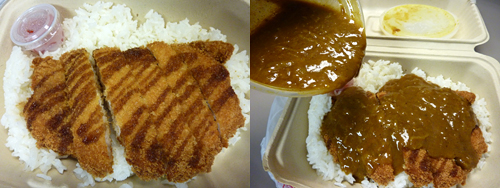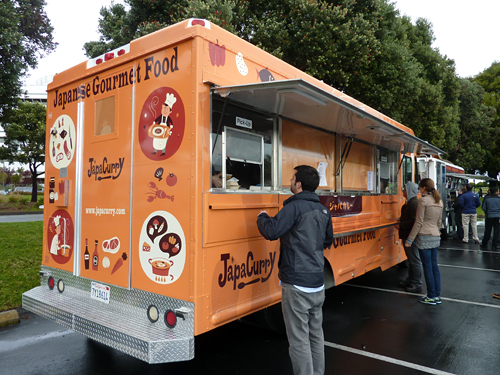Some have talked about their Chicken Katsu Curry lately, but using chicken is a variation of the original and more traditional Pork Cutlet, or “Tonkatsu” Curry served in Japan, so that’s what I opted for. I was instantly impressed when I open the clamshell box.
The cutlet was breaded and fried to a perfect shade of golden brown and had streaks of brown katsu sauce over the top that not only added flavor, but made for a lovely presentation, especially considering the food came from a truck.
I was even more pleased once I bit into the pork. Despite a 10 minute drive back to my office, the breading was still crisp and never separated from the meat; a true sign of good tonkatsu. The meat itself was juicy and tender, not at all dry. It was obviously a good cut of pork because there was enough fat to ensure juicy meat, but not too much to seem greasy.

The curry was more of a sauce than a thick gloppy stew like you’d see at many Japanese restaurants around town. Hamada says that’s because many Japanese restaurants in America don’t make their curry from scratch. Many times they use curry stock cubes that you buy from an Asian supermarket.
The curry I had had a definite kick, even though I ordered the “regular,” not that I’m complaining. The flavors were also much more robust and had a definite warmth that came from the variety of spices, including cumin, coriander, cardamom, mustard seed, turmeric, and a little bit of apple or peach, when in season, to add a touch of sweetness.
Hamada’s recipe is one he developed on his own, after stints at Tanpopo Restaurant in San Francisco and Wakuriya Restaurant in San Mateo. But his background is actually in technology. After getting laid off, he decided to give his passion for food another shot. He even returned to Tokyo to become a trained ramen maker.
But once he returned to the States, he noticed the food truck trend taking off. “I saw food trucks in downtown San Francisco and decided it was a better option because real estate was so expensive. And I used to work at an office, so I know that people want a quick lunch. I thought curry was better for that reason, and it’s easier to serve off a truck than ramen.”
The menu is extremely short with only pork or chicken cutlet, pork Kurobata sausage, veggie and veggie croquette curry options, plus the occasional bento box. But this curry is the real deal. The quality and flavor of my meal was excellent considering it came from a truck. And eight dollars will get you a healthy portion that’ll satisfy your lunch craving.
Hamada says he has no plans to expand outside of San Francisco, for now, but he does want to expand his menu to possibly include a seafood and beef curry. And he hasn’t abandoned his love of ramen, either. “I miss ramen! That’s still my goal. I’d love to have another truck, or maybe I’ll do a ramen restaurant.”
As for all this hoopla he’s been experiencing lately with the restaurants he’s offended downtown, he regrets not doing things differently in the beginning. “I would’ve introduced myself to the businesses in the neighborhood to explain what I do and let them know before I went out there. Overall, some restaurants are skeptical, but many want to try my food and are supportive.”
He admits, though, all this press attention has actually helped business. “My foot traffic has been great because people are curious. Customers have been very supportive and say good things to me like, ‘Keep it up!’”
Some brick and mortar restaurants may not want a food truck in their neighborhood. But the reality is if the food is good, people will come back, and the public will ultimately get to determine who stays and who goes.
JapaCurry Food Truck
Various locations in San Francisco, including Sansome and Pine, Howard and 1st St., Mission and New Montgomery, and 8000 Marina Blvd. in Brisbane.
11:30am – 1:30pm
Twitter: @JapaCurry

